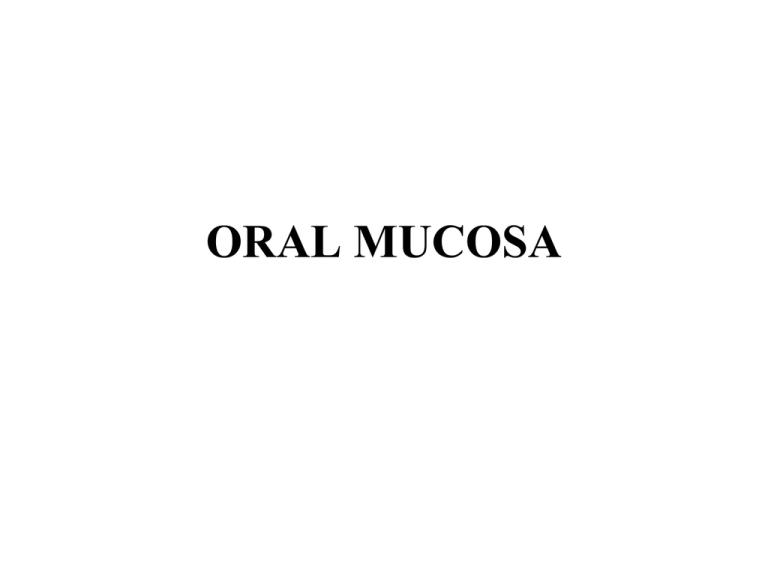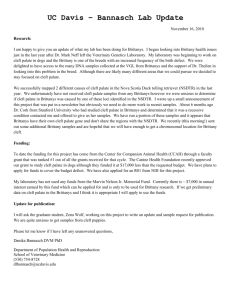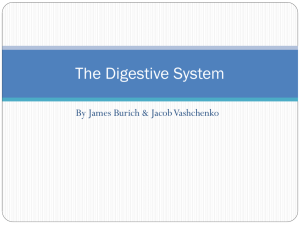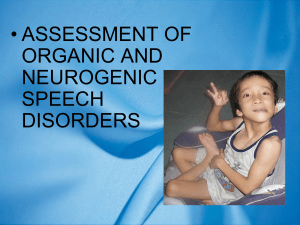ORAL MUCOSA
advertisement

ORAL MUCOSA Oral Mucosa • first space of the mouth – laterally and in front: alveolar arches – posteriorly: isthmus of the fauces • it is a nearly ovalshaped cavity Anatomy • two rows of teeth supported by facial bones of the skull, the maxilla above and the mandible below • teeth are surrounded by gingiva, which supports the tissue of oral cavity protection • other structures that aid chewing are the lips, cheeks, tongue, hard palate, soft palate, and floor of the mouth Anatomy • Vestibule – externally: lips and cheeks – internally: gums and teeth – communicates with the surface of the body by the rima or orifice of the mouth – receives the secretion from the parotid salivary glands Anatomy • Mouth Cavity Proper – cavum oris proprium – laterally and in front: alveolar arches with their contained teeth – behind: communicates with the pharynx by isthmus faucium – roofed by the hard and soft palates, floor is formed by the tongue – receives the secretion from the submaxillary and sublingual salivary glands Anatomy • Lips – labia oris – surround the rima or orifice of the mouth – externally: integument – internally: mucous membrane – inner surface is connected in the middle line to the corresponding gum by the frenulum Anatomy • Gums – gingivœ – dense fibrous tissue – closely connected to the periosteum of the alveolar processes, and surrounding the necks of the teeth – covered by smooth and vascular mucous membrane Anatomy • Hard Palate – palatum durum – anterior and lateral: alveolar arches and gums – continuous with the soft palate – covered with stratified squamous epithelium – furnished with numerous palatal glands Anatomy • Soft Palate – palatum molle – movable fold, suspended from the posterior border of the hard palate – forms an incomplete septum between the mouth and pharynx Anatomy • Soft Palate – anterior surface: concave, continuous with the roof of the mouth, and marked by a median raphé – posterior surface: is convex, and continuous with the mucous membrane covering the floor of the nasal cavities Anatomy – upper border: attached to the posterior margin of the hard palate – sides: blended with the pharynx – lower border: free – palatine velum: hangs like a curtain between the mouth and pharynx – palatine uvula: small, conical, pendulous process that hangs from the middle of its lower border – arches or pillars of the fauces: two curved folds of mucous membrane, containing muscular fibers Anatomy • Teeth – dentes – deciduous or milk teeth • twenty in number: four incisors, two canines, and four molars – permanent teeth • thirty-two in number: four incisors, two canines, four premolars, and six molars Anatomy • Teeth – crown: projecting above the gum – root: embedded in the alveolus – neck: the constricted portion between the crown and root Anatomy Lower central incisors 6 to 9 months. Upper incisors 8 to 10 months. Lower lateral incisors and first molars 15 to 21 months. Canines 16 to 20 months. Second molars 20 to 24 months. Anatomy First molars 6th year. Two central incisors 7th year. Two lateral incisors 8th year. First premolars 9th year. Second premolars 10th year. Canines 11th to 12th year. Second molars 12th to 13th year. Third molars 17th to 25th year. Salivary Glands • Parotid Gland – – – – glandula parotis largest of the three weight: 14-28 gm side of the face, below and in front of the external ear – main portion of the gland: between the ramus of the mandible in front and the mastoid process and sternocleidomastoideus behind Salivary Glands • Submaxillary Gland – glandula submaxillaris – size of a walnut – situated in the submaxillary triangle – submaxillary duct: 5 cm. long • opens by a narrow orifice on the summit of a small papilla, at the side of the frenulum linguæ • lies between the lingual and hypoglossal nerves, but at the anterior border of the muscle it is crossed laterally by the lingual nerve • Vessels and Nerves – blood supply: branches of the external maxillary and lingual – nerves: submaxillary ganglion • receives filaments from the chorda tympani of the facial nerve and the lingual branch of the mandibular nerve Salivary Glands • Sublingual Gland – glandula sublinguali – smallest of the three glands – beneath the mucous membrane of the floor of the mouth, at the side of the frenulum linguæ – weighs nearly 2 gm – Above: mucous membrane; below: Mylohyoideus; behind: deep part of the submaxillary gland; lateral: mandible; and medial: Genioglossus – separated by the lingual nerve and the submaxillary duct • excretory ducts: 8-20 – ducts of Rivinus join the submaxillary duct – duct of Bartholin joins the sublingual duct which opens into the submaxillary duct • sublingual and submental arteries • nerves: lingual, the chorda tympani, and the sympathetic innervation Anatomy • Accessory Glands – posterior part of the dorsum of the tongue behind the vallate papillæ – large numbers are present in the soft palate, the lips, and cheeks – same structure as the larger salivary glands – mucous or mixed type Function • begins digestion by mechanically breaking up the solid food particles into smaller pieces and mixing them with saliva • plays an important role in speech, facial, expression,kissing, eating, drinking, breathing – infants: sucking reflex Diseases Cleft Lip and Palate • cheiloschisis and palatoschisis • failure of fusion of the maxillary and medial nasal processes • cleft is a fissure or opening—a gap – non-fusion of the body's natural structures that form before birth Cleft Lip • small gap or an indentation in the lip (partial or incomplete cleft) or it continues into the nose (complete cleft) • lip cleft can occur as a one sided (unilateral) or two sided (bilateral) Cleft Lip • within the first 2–3 months after birth, surgery is performed to close the cleft lip • "rule of 10s" (Wilhelmmesen and Musgrave in 1969) – the child is at least 10 weeks of age – weighs at least 10 pounds – at least 10g hemoglobin Cleft Palate • condition in which the two plates of the skull that form the hard palate (roof of the mouth) are not completely joined. • failure of fusion of the lateral palatine processes, the nasal septum, and/or the median palatine processes (formation of the secondary palate) Cleft Palate • occur as complete (soft and hard palate, possibly including a gap in the jaw) or incomplete (a 'hole' in the roof of the mouth, usually as a cleft soft palate) • a direct result of an open connection between the oral cavity and nasal cavity is velopharyngeal insufficiency • corrected by surgery usually performed between 6 and 12 months • 20-25% only require one palatal surgery to achieve a competent velopharyngeal valve capable of producing normal, nonhypernasal speech Malignant Tumors • Lips – squamous cell carcinoma of the lower lip (90%) – risk factors: pipe smokers, prolonged intense sun exposure – symptoms: intractable ulcerations in the vermillion border, large exophytic lesions – diagnostic: biopsy – treatment: surgical excision – low rate of metastasis to regional lymph nodes Malignant Tumors • Oral Cavity – squamous cell carcinoma – risk factors: long history of nicotine and alcohol abuse – symptoms: painful swallowing, blood-tinged saliva, fetid breath odor – diagnosis: visual inspection, bimanual palpation, imaging – treatment: surgery and radiation therapy





